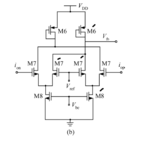simplsoft
Full Member level 2

Follow along with the video below to see how to install our site as a web app on your home screen.
Note: This feature may not be available in some browsers.






Now I cant understand the diode connected transistor M6 and M6'. Why Vfb is taken from the drain of M6' not from drain of M6?


